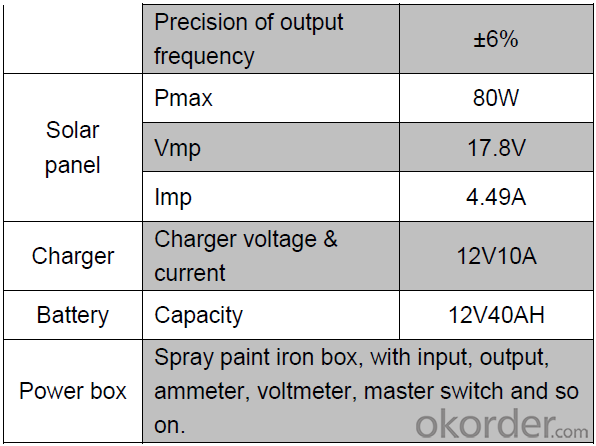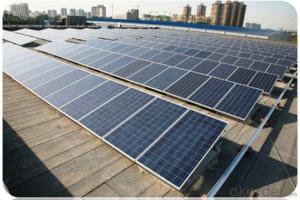Grants for Solar Energy Systems:CNBM-K2 80W Solar Home System with Good Quality
- Loading Port:
- China main port
- Payment Terms:
- TT or LC
- Min Order Qty:
- 1 pc
- Supply Capability:
- 1000000000 pc/month
OKorder Service Pledge
OKorder Financial Service
You Might Also Like
CNBM SOLAR is a world-leading and Vertical integrated manufacturer of high-performance with Silicon, Wafer, Cells, Modules, which convert sunlight into electricity for residential, commercial, and utility-scale power generation.
The capacity of CNBM SOLAR is reach to 1GW, and make sure each year our shipment capacity is more than 700-800MWs, at the same time, we have set up the largest solar power station with our partner in Ukraine.
CNBM is a Quality + Service oriented company with“Excellence at Each Step” approach, composed of the finest components from TUV and IEC-certified partners around the world, CNBM modules consistently undergo a variety of trials at the company’s Test & Development Centre, ensuring peak performance capabilities.
The company is committed to develop and provide the world with clean and renewable energy to ease the energy shortages as well as human kind’s impact on the environment.
Data:




FAQ:
Could you pls introduce more about CNBM?
CNBM Group is short for China National Building Materials Group Corporation, which is established in 1984 with approval from the State Council
CNBM Group is the largest comprehensive building materials industry group in China
The Group has a total asset of over RMB 360 billion, more than 180,000 employees and 17 subsidiaries
- Q: How do solar energy systems impact electricity bills?
- Solar energy systems can have a significant impact on electricity bills by reducing or even eliminating the need for traditional grid electricity. By harnessing the power of the sun, these systems generate clean and renewable energy, which can offset a substantial portion of a household's electricity consumption. This can result in lower monthly bills or, in some cases, provide excess energy that can be sold back to the grid, further reducing overall costs.
- Q: Can a solar energy system be installed in an area with a high fire risk?
- Yes, a solar energy system can be installed in an area with a high fire risk. However, extra precautions and safety measures need to be taken to minimize the risk of fire, such as using fire-resistant materials, proper spacing between panels, and regular maintenance to prevent debris accumulation.
- Q: Can solar energy systems be used in powering traffic signals?
- Indeed, traffic signals can be powered by solar energy systems. Photovoltaic (PV) modules, also known as solar panels, have the capability to convert sunlight into electricity, which can then be utilized to operate various devices, including traffic signals. This alternative approach to powering traffic signals presents several advantages when compared to the traditional grid-powered method. Firstly, solar-powered traffic signals are environmentally friendly as they do not rely on fossil fuels or emit greenhouse gases while in operation. This is advantageous in terms of reducing carbon footprint and addressing the issue of climate change. Secondly, solar-powered traffic signals are not reliant on the electrical grid, thereby ensuring a higher level of reliability during instances of power outages or grid failures. They can continue to function even when the main power supply is disrupted, therefore ensuring the smooth flow of traffic and maintaining road safety. Furthermore, solar-powered traffic signals necessitate minimal upkeep in comparison to their grid-powered counterparts. Once installed, solar panels have a long lifespan and only require periodic cleaning to ensure optimal performance. This minimizes the need for frequent repairs and maintenance, leading to cost savings for traffic management authorities. Lastly, solar-powered traffic signals can be conveniently installed in remote or off-grid locations where it would be difficult or expensive to extend the electrical grid. This makes them a viable solution for rural areas or areas with limited infrastructure. In conclusion, solar energy systems offer an effective and sustainable solution for powering traffic signals. They offer numerous benefits, including environmental friendliness, reliability, low maintenance, and suitability for remote locations. With the continual advancement of solar technology, the utilization of solar-powered traffic signals is expected to increase, contributing to a more environmentally conscious and efficient transportation system.
- Q: Can solar energy systems be used in areas with high population density?
- Yes, solar energy systems can be used in areas with high population density. In fact, they can be particularly beneficial in densely populated areas where the demand for electricity is high. Solar panels can be installed on rooftops, buildings, and even in urban spaces like parks and parking lots, allowing for efficient use of available space. Additionally, advancements in solar technology and the use of solar farms can further accommodate the energy needs of densely populated areas.
- Q: Can solar energy systems be installed in areas with high winds?
- Yes, solar energy systems can be installed in areas with high winds. In fact, it is important to consider wind speeds when installing solar panels to ensure their structural integrity and longevity. Solar panels are designed to withstand various weather conditions, including high winds. Proper installation techniques, such as utilizing strong mounting systems and securing panels with appropriate fasteners, can enhance their resistance to wind damage. Additionally, some solar panel manufacturers conduct rigorous testing to ensure their products can withstand high wind speeds. It is recommended to consult with a professional installer who can assess the specific conditions of the area and design a solar energy system that can effectively withstand high winds.
- Q: Do solar energy systems require a lot of maintenance?
- No, solar energy systems generally require very little maintenance.
- Q: Can solar energy systems be used for electric vehicle charging stations?
- Yes, solar energy systems can be used for electric vehicle charging stations. By installing solar panels, the energy generated from the sun can be used to charge electric vehicles, making them more sustainable and reducing dependency on traditional energy sources. This integration of solar energy and electric vehicle charging helps promote renewable energy and contributes to a greener transportation system.
- Q: Can solar energy systems be used in areas with limited access to food?
- Yes, solar energy systems can be used in areas with limited access to food. Solar energy systems provide a sustainable and reliable source of electricity, which can power various applications, including food production and processing. Solar-powered irrigation systems can be used to water crops, while solar-powered refrigeration can help preserve food. Additionally, solar energy can be utilized to power hydroponic or vertical farming systems, enabling food production in limited spaces. Therefore, solar energy systems can play a crucial role in addressing food scarcity and promoting food security in areas with limited access to food.
- Q: What are the different system monitoring options for solar energy systems?
- Some of the different system monitoring options for solar energy systems include real-time data monitoring, remote monitoring, cloud-based monitoring, and mobile app monitoring. These options allow users to track the performance of their solar energy system, monitor energy production, detect any issues or faults, and optimize system performance.
- Q: Can solar energy systems be used in commercial or industrial applications?
- Yes, solar energy systems can definitely be used in commercial or industrial applications. In fact, many businesses and industries around the world are increasingly adopting solar energy systems to power their operations. These systems can be installed on rooftops, parking lots, or ground-mounted, providing a reliable and sustainable source of electricity. Not only does solar energy help businesses reduce their carbon footprint and lower their energy costs, but it also provides them with long-term energy independence and resilience.
Send your message to us
Grants for Solar Energy Systems:CNBM-K2 80W Solar Home System with Good Quality
- Loading Port:
- China main port
- Payment Terms:
- TT or LC
- Min Order Qty:
- 1 pc
- Supply Capability:
- 1000000000 pc/month
OKorder Service Pledge
OKorder Financial Service
Similar products
Hot products
Hot Searches
Related keywords


























